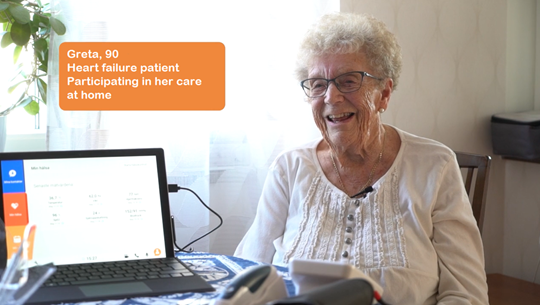The virtual Home Hospital in Borgholm is part of the Borgholm model; a model for conducting good and close care. The Borgholm model is based on collaboration and on the fact that there is good enough staffing of all occupational groups. The Borgholm model is in continual developement and currently has the following components:
Borgholm groups
All employees at the Borgholm Healthcare Centre leads the unit together. Six interdisciplinary ”Borgholm groups” work structured and standardized on issues and improvement ideas.
Senior Advisor
Experienced retired general practicioners have been hired at the Healthcare Centre. Some of them are always on duty, to give medical advice to all staff. They have no listed patients and do no journal notes.
Dandelion group
Reference group consisting of people who work extra at the Healthcare Centre, among others the Senior Advisors. Dandelion group examines procedures and effects from both outside and inside angle and comes with improvement suggestions.
Acute team
Medical assisted nursing for fast assessment. In about half of the cases a nurse/district nurse can handle a case without the patient being presented to a doctor. In some cases it quickly becomes apparent that patient needs a doctor immediately.
Referral group
All non-acute referrals are reviewed and commented by all doctors at the Healtcare Centre in a joint session once a week. When reviewed and approved, referral is sent to the hospital with the supplement ”through the Borgholm referral group”. This procedure has led to fewer forwarded referrals, and that the hospital handle referrals quickly, and also less reject of referrals. In addition, consensus and cohesion are strengthened.
Integration Team
The competence, developed at the Borgholm Healthcare Centre during a period of many asylum seekers, is now taken advantage of to integrate doctors with foreign descent. In order to acquire Swedish healthcare system and approach, each of these doctors now has a Senior Supervisor and a very experienced District Nurse at side in everything they do. In parallell, they recieve education in the Swedish language.
Team with Specialist Nurses
Single-handed work rarely works in the long run and therefore there are always at least two Specialist Nurses in each special area for asthma / COPD, diabetes, heart failure and dementia. The Specialist Nurses limit the specialist efforts to three days per week and therefore change tasks regularly. Dementia and Diabetes Nurses do home visits. Specialist Nurses in heart failure and lifestyle do in collaboration with doctor follow-up after heart attack.
Kex Borgholm (”Kex” is a wordplay, from ”Lex”)
An action plan for how to handle different approaches. Daily reflection time gives all staff the opportunity to sort things out directly and a checklist exists in cases where the dialogue needs support. If the situation cannot be resolved with the help of the checklist, peer support is contacted. For organizational issues, contact should be taken with the Head of Clinic. The purpose is to have a climate where the staff feel secure in always being directly informed.
Continous improvement One of the major challenges is the continued individualisation of the healthcare supply. Of course, the aim is to have a fully digitized Healthcare Centre as soon as possible.
Home hospital
The virtual Home Hospital is a seamless collaboration between Healthcare Centre, Ambulance Care, Home Care and Home Healthcare. In order for the Home Hospital to function, in addition to good staffing, important factors are: access to patient journal, well-functioning contact paths for collegial consultation, and the opportunity to quickly get home visit by a doctor. In Borgholm, all specialist doctors reserve the time at 11:00 to 12:00 for emergency home visits. The time can be booked by the Municipality's nurses, ambulance nurses or by district physicians (after telephone contact with the patient). District doctors follow up the patients, the Municipality's district nurse is no longer alone in their responsibility. Ambulance nurses do not need to drive patient to hospital for safety reasons. The Home Care staff's expertise is better utilized, among other things through increased knowledge of seeing signs of deterioration.
Journal access
Common journal is one of the basic prerequisites for the working method. Since the turn of the year 2016–17, the journal system provides information every morning, about which of the Health centre's patients have been admitted to the County Hospital since yesterday. The doctor can, via the journal, receive information about the situation and, if necessary, call the department for reconciliation; reverse care planning.
About project home monitoring
The heart failure patients who used the digital monitoring tool Cuviva were 70 years or older and they usually had little or no experience of new technology.
There is the possibility to introduce working methods reminiscent of the Borgholm model and the Home Hospital in other parts of Sweden and the Nordic countries. The monitoring tool Cuviva could probably be used and create value for both more heart failure patients and other needs groups.
 Distance treatment
Counseling via online tools with associated treatment or own treatment.
Distance treatment
Counseling via online tools with associated treatment or own treatment.
 Distance monitoring
Social care remotely with sensors, cameras, reminders and data collection.
Distance monitoring
Social care remotely with sensors, cameras, reminders and data collection.
 Distance meetings
Close care concepts that move the point of healthcare closer or into the citizens' own homes.
Distance meetings
Close care concepts that move the point of healthcare closer or into the citizens' own homes.
 New distance-spanning solutions
New innovative solutions, new national infrastructure for digital services and service models where citizens can take greater responsibility.
New distance-spanning solutions
New innovative solutions, new national infrastructure for digital services and service models where citizens can take greater responsibility.
 Show all solutions
Show solutions from all four categories
Show all solutions
Show solutions from all four categories
